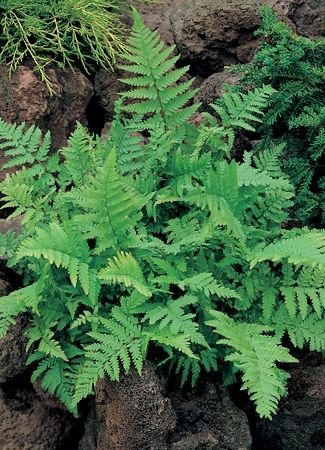History of Houseplants
 |
|
Most Ferns make for good houseplants
|
For those of us living in the northern reaches of the country, where winter brings frozen ground, dormant landscape plants and short days, having something that is alive and green to look at helps not only lift one’s spirit but provides an opportunity for getting our hands a little dirty. There is documented evidence that houseplants absorb air pollutants and purify the air. This can provide a significant benefit whether inside a home or office. Roughly 15 houseplants can purify almost 1800 square feet. Some do this better than others (see list below).
Another study has documented that, “Flowers have immediate and long-term effects on emotional reactions, mood, social behaviors and even memory for both males and females.” (Evolutionary Psychology– ISSN 1474-7049-Volume 3, 2005). Houseplants alone or in combination with flowers have long been used to convey sympathy, to evoke forgiveness for misdeeds, for romance and celebration. Both giving and receiving plants brings happiness and pleasure to people. People who give plants/flowers are considered more likeable, friendly and emotionally intelligent. They are regarded as highly caring, trustworthy, loving, successful and valuing achievement and beauty in life.
So, how do you know which plants are right for you or to give to someone else?
There are a few factors that are essential to successful houseplant growth. These are temperature, water/humidity and light.
Light
Light affects plants in many ways. Light duration, quality and intensity all play a roll. Low light plants will be able to sustain themselves without supplemental lighting, but, can also be grown at higher light intensities. However, plants that require higher level light may require supplemental light to prevent them from dropping leaves and becoming spindly.
Temperature and Humidity
Despite the fact most of these plants are tropical; nearly all can survive quite happily in temperatures ranging between 65-75 degrees Fahrenheit. They do prefer more humidity than we usually have in our homes during the winter. If possible set up a humidifier near them, or place them in groups on saucers or trays filled with pebbles and water. As the water in the trays evaporates, it provides higher humidity in the area surrounding the plants. Keeping your thermostat at a lower temperature not only helps your heating bill but extends the bloom time on flower plants. Misting plants helps. Using filtered or distilled water to do this will eliminate the water spots from mineral and salt build up that occurs when tap water evaporates on the leaves.
Water
In actuality, the thing that creates more problems than any other for houseplants is over watering or inconsistent watering. Keeping the soil constantly moist will result in root rot, especially in low light conditions, will result in root rot. The water used should be at room temperature. The idea is to thoroughly water the plant – continue to water until it comes out the bottom. After 20-30 minutes, if water is still in the saucer, dump it out. It you notice a white crust developing on the pot edges or top of soil, this is from salts in the water. Some plants do not respond well to this. If this seems to be an issue, water with distilled or filtered water and repot using new soil. Once you develop a routine of watering, try to be consistent. The plants will adapt, and remember, it is better to water less than more.
